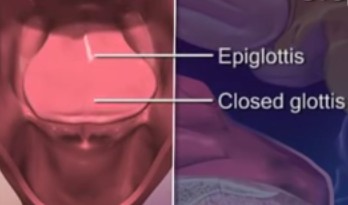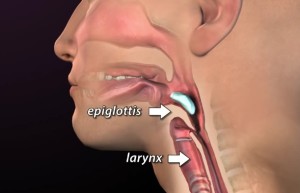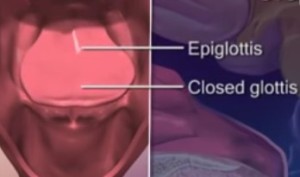Epiglottis is a flap-like cartilage that is situated behind the tongue in throat and in frontal area of larynx. It rests upright and allows air to pass through larynx to the lungs. Epiglottis is an elastic cartilage tissue and is covered with mucous membrane. It attaches itself just at the entrance of larynx. Larynx is a tube-shaped organ also known as the voice box. Epiglottis also contains taste buds. It is ideal in swallowing of food. When swallowing food, the epiglottis flops down over windpipe to prevent food from going into lungs.
Every time you eat, you would choke or cough if you had no epiglottis. Epiglottis acts as switch in between the voice box or larynx and the esophagus, whereby it allows air to enter airways and the lungs while also allowing food to pass into gut. It also protects one from choking on food when the airway is obstructed.
When swallowing food or liquids, the epiglottis folds backward to block the entrance of larynx thereby preventing the food and liquids from entering in windpipe and the lungs. Epiglottis returns to its upright position once you have swallowed food or liquids.
Epiglottis is among the nine cartilaginous structures making up voice box or the larynx. During breathing, epiglottis lies down completely within larynx and during swallowing; it turns to serve as part of anterior of pharynx.
Anatomy of epiglottis
When viewed from posterior direction, epiglottis appears like a teardrop forming a wide and rounded region at its superior end and a slender tapered point at inferior end. It also appears concave with some lateral edges, which point posteriorly. Epiglottis is held in a resting position in throat by two little ligaments called the hyoepiglottic and thyroepiglotti ligaments.
The inferior part of epiglottis is connected to the thyroid cartilage of larynx by the slender thin thyroepiglottic ligament. The anterior surface of epiglottis is connected to the hyoid bone by the hyoepiglottic ligament.
The anterior surface of epiglottis is made up of stratified squamous epithelium cells that are nonkeratinized. On the posterior area, the epiglottis consists of pseudostratified columnar epithelium cells. A lean layer of areolar connective tissue is found under the epithelial layer and it provides a wobbly or some loose attachment for epithelium. This connective tissue supplies epiglottis with nerve fibers and blood vessels.
The elastic cartilage of epiglottis is the thickest and deepest layer consisting of gel-like matrix and elastin protein fibers. It is this elastic cartilage, which gives epiglottis a flexible yet firm elastic structure. The flexibility and elasticity is what makes the epiglottis to perform its complex role. The different structures of head and neck work together to help epiglottis to perform its function.
Epiglottis – Pictures
Function of the epiglottis
In much of its time, the epiglottis remains relaxed at larynx’s superior edge and just posterior to tongue. When in this position, epiglottis allows air to enter the pharynx from the mouth or nose and freely pass into larynx as it heads to the lungs. However, when you swallow food, it is that time the epiglottis moves and offers its vital function to prevent food or liquids from entering the airways and lungs.
Usually, the process of swallowing food or liquids is a complex one, and it involves many structures of the neck and head. During swallowing, the pharynx, larynx, and hyoid are pulled superiorly thereby allowing pharynx to enlarge and receive the substances that are being swallowed.
The movement of hyoid then triggers the superior part of epiglottis to flap down on top of glottis. By doing so, it covers the opening of air passageways. The food that is entering pharynx will now pass over the epiglottis’s anterior surface that is now forming the roof of glottis. The food then continues to enter the esophagus that is situated just posterior to pharynx.
At the upper part of epiglottis, the glossopharyngeal nerve supplies fibers, which contribute to afferent limb of gag reflex. To the lower part of epiglottis, a laryngeal stem of the vagus nerve supplies fibers, which contribute to efferent limb cough reflex. Epiglottis also plays some role in languages whereby it is used in producing epiglottal consonant speech sounds, which are often very rare types of sounds.
Clinical significance of epiglottis
At times, when there is inflammation of epiglottis, it may result in a condition known as epiglottitis. This is mainly caused by a bacteria known as Haemophilus influenzae. Epiglottitis presents with symptoms such as sore throat, fever, problem with swallowing, and difficulty in breathing. Epiglottitis can block the smooth flow of air to lungs and it could life threatening if not checked. It may be caused by many things such as throat injury, bacterial infection, hot beverages, and burns.
In essence, epiglottis has an important role in regulating and controlling the way people swallow food and breath. It ensures that one is choked by food and the food or liquid does not go into the airways to lungs.


